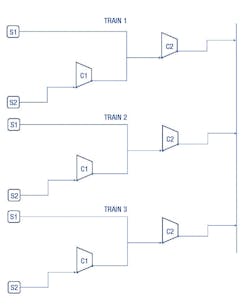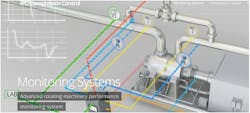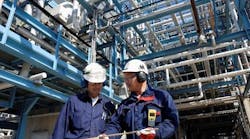Control systems are the brain of a process plant. Their importance is well-recognized, and for this reason, the design and implementation of plant control systems are considered — from the first design until the final startup stages. Medium and large plants may include many different process areas with different kinds of machines. Each one of the involved processes may require special attention and precautions to render the best outputs and help maximize overall plant performance. Despite their importance, the plant’s control system oftentimes may not be fully optimized.
This paper focuses on centrifugal compressor plants, introducing some main concepts applicable to the compression station control system. Furthermore, a case history is presented for the optimization applied by the IPC team to the plant control system.
Here, this paper also provides evaluation of the benefits and estimation of the environmental impact.
Compression station control system elements
Each compression station includes a station control system. This system includes all the devices devoted to managing, controlling and protecting the plant’s physical assets, including machinery, piping, drivers, instrumentation and auxiliaries.
Controlling a compression station requires at least two main tasks: assure an adequate machinery protection and assure the plant stability, meaning that the main plant parameters should be fluctuating during operational time within the expected operative range. Plant stability is then the result of the effective control system capability to coordinate all machinery and devices during the operational time. Plant stability helps avoid unwanted phenomena such as recycles and shutdowns, described later.
The following gives an overview of the main areas that make up a compression station control system.
Instrumentation
API STD 617 provides detailed indications about compressor instrumentation. Onboard equipment should include vibration and temperature probes. Sensors are normally located in proximity to rotor bearings where vibration and temperature readings are taken and compared to alarms and trips. Field instrumentation assures that the machine will not operate outside the permitted range. Machinery as well as process items (such as headers, scrubber and coolers) are often equipped with sensors to detect potentially anomalous or even dangerous conditions. Instrumentation represents the base layer of the control system upon which all logic and control actions are based.
Control tasks
One of the main tasks is the load control. This task allows for maintaining a mass balance between the incoming gas into the station and the outcoming gas. This may appear as a simple task but in reality, it is more complex, and many problems are normally faced, especially when the station has a less simple architecture, such as stations with more compression trains in parallel. The load control is usually carried out by acting on the speed of the driving motor (frequently, a gas turbine for turbo-compressors) or by acting on the throttle valve in the case of constant speed drivers (frequently, asynchronous motors for motor compressors). It should be noted that the load control has the suction header pressure as a process parameter. But the same suction pressure affects the flow in the anti-surge valve, which is controlled by the anti-surge controller. If these two control actions should occur at the same time, they would influence each other, and the station could be destabilized by persistent oscillations, potentially triggering recycles and shutdowns.
The situation is complicated by the fact that, in some circumstances, the anti-surge valves are used for the load control, thus adequate strategies are needed to accommodate these events, always assuring an overall station stability.
Other factors must also be considered for the purpose of system stability, such as the closing speed of the anti-surge valve, when and under which conditions the anti-surge valve closure should be permitted, how to manage the single compressor recycle when working in a compression train, how to manage more trains in parallel, how to manage a compressor ramp up into the parallel, and so on.
These considerations show the delicacy and importance of the compression station control system duty and how it may require a high level of sophistication in case of nontrivial plant configurations.
Dangerous operative conditions
Surge
Among critical operative conditions, the surge deserves a special mention: It occurs in a very quick inversion of the flow inside the compressor, which happens when the characteristic curve becomes unstable, i.e., when the derivative of the discharge pressure versus the flow approaches zero. Surge has a destructive nature: The inversion of the flow causes high vibrations and violent axial displacements that overload the bearings. During the surge cycles, the gas may achieve very high temperatures, causing damage to the compressor parts.
Most of the time, the actual operative conditions are different from design ones; consequently, the identification of the compressor surge point becomes complicated because it requires the adjustment of the compressor performance curves at the actual off-design conditions. While this capability is provided by IPC software Cmap, traditional systems are often still based on approximated methods that, when implemented, are quite conservative and set the protection thresholds far from the surge point. This often causes the compressor to enter the recycle condition, even when not strictly necessary.
While this approach goes in the direction of machine safety, it causes, as a counterpart, a higher financial and environmental impact. In fact, during operational time, plant instabilities may trigger the protection actions. This causes the compressor to go offline, and the incoming gas to the station is inevitably burned in the flare.
Recycles and shutdowns
Recycles and shutdowns also deserve a short explanation since they both have a critical impact on plant productivity. Shutdowns are critical events that require the machine to be stopped immediately. This happens usually when some of the critical operative parameters exceed alarm values, hitting the trip point. Of course, shutdowns represent lost money for lost production during time intervals necessary to reset the system and restart.
Recycles occur in the recirculation of the compressed gas back from the machinery discharge to the suction side. The recycling of a centrifugal compressor is most often due to the triggering of the anti-surge valve emergency opening. This protection action is actuated by the control system when the operative flow becomes very near to the surge point (normally, 1.03 of surge flow).
Also, recycles affect the overall station productiveness since they require the system reset, although compressors are not stopped. System reset requires human intervention for acknowledgment and problem understanding and is therefore time-consuming. The first step of a recycle is where the machine enters into protection mode (anti-surge emergency opening) and remains in this status until operator acknowledgement, and the second step is when the machine recovers its load. Also, recycles represent a loss of production because the gas continues to be flared until the completed machine reloading, causing a neat loss of gas production, a loss of energy for unnecessary compression power, a CO2 equivalent impact for this wasted energy and a high impact for the CO2 injected into the atmosphere.
Case study
In this case history, the compression station was made up of three independent compression trains (independent gas sources), with each train including two compressors in a series. Each train was driven by a single fixed-speed electrical driver. Each single compressor was equipped with its own anti-surge valve.Before the beginning of the plant optimization project, the compression plant was affected by a high number of critical events, mainly recycles and shutdowns.
After an observation period dedicated to understanding the problems and the behavior of the system, the IPC team proposed to plan management to move along the following main directives to obtain an increased level of plant stability:
- Evaluation of the compressor performance, through the comparison of the operational values to the OEM expected performance.
- Observation of the plant dynamical behavior with understanding of the interconnection of the effect of the plant parameter fluctuations with the machine operative performance.
- Execute detail analysis of all the involved control system tasks and design of control tasks modification aimed to reduce or minimize the appearance of critical events.
The first directive was applied using the available field measurement data and applying that to the capabilities of IPC’s Cmap software.
Cmap largely contributed to identifying compressor performance nonconformity and then updating control system settings for the effective compressor operative conditions. The flexibility, reliability and quickness of the software contributed to a better picture of the overall system operational status.
Financial and environmental impact of the optimization
Before the launch of the optimization project, the plant was affected by an average of 1 recycle per day per train with a duration of about a half-hour per recycle.
In these transients, each compression train was recycling about 40,000 kg/h, with the overall station flaring about 72,000 kg/day. The estimated loss for flared gas was about 4.6 million euros per year, including loss of production and cost for energy spent on recycles.
During recycles, the train was wasting about 3 MW with an estimated loss of about a quarter-million euros per year due to unnecessary adsorbed electrical power.
The total loss: about 4.9 million euros per year.
From an environmental perspective, the situation was even worse: The CO2 equivalent introduced in the atmosphere for the unnecessary recycling power was about 1,160 tons per year, while the CO2 flared was about 70,400 tons per year, and a CO2 equivalent for heat wasted by flaring was about 13,500 tons per year.
This amount of CO2 would be equivalent to the amount of CO2 produced in a year by 42,720 passenger cars. Another interesting comparison: About 18 medium-size wind turbines (2.2 MW) would be necessary to avoid the introduction in the atmosphere of the same quantity of CO2, with a cost of about 40 million euros.
Conclusion
Following the history and data presented in this paper, one consideration emerges: All efforts toward any possible improvements of process plant control systems and for compression plant controls optimization strategies are justified from both a financial and environmental impact.
The adoption of advanced strategies for machinery monitoring and station control systems represents a justified investment from a financial point of view.
From an environmental perspective, benefits are also evident: The gas industry, beyond its financial goals, also bears the moral responsibility for environmental compliance, thus is spurred to apply improvements and innovations on the control system area.
Knowledge of compression systems, application experience and the support of specialty machinery software tools such as Cmap can be therefore considered as valid support in the achievement of not only economic benefits but also environmental goals and responsibilities.
Massimiliano Di Febo is operation manager at IPC. He can be reached at [email protected].
Pasquale Paganini is a technical manager at IPC. He can be reached at [email protected]. For more information, visit ipc-eng.com or compressormap.com.




